By Mélody Laye
You’re about to welcome a new baby in your life or he’s already arrived and you’d like to get started wearing your baby? What a wonderful idea! Yes, there are many benefits to babywearing like strengthening your bond with your baby, being able to respond to his needs quickly, or gaining more autonomy while keeping your baby close to you. On top of it all, babywearing facilitates breastfeeding and allows you to take your baby everywhere with you! Are you ready to try it?
Before we continue, know that it’s possible to wear a baby from his very first days after being born but take note that he should be weighing at least 7 lbs (3,2 kgs) to do so. This means that with premature babies and babies born underweight it’s preferable to wait until they reach a safer weight. Until you can wear your baby, you’ll still be able to enjoy skin to skin and its benefits.
Tip 1: If you can, practice in advance:
If you have time during your pregnancy and what it takes to do it (a baby carrier, baby wrap, skin-to-skin garment, ring sling, etc.), you can practice putting on and adjusting your baby carrier or wrap. That way, babywearing will be easier to get into as soon as the baby arrives. There are lots of free instruction videos on baby carriers and baby wraps and their different possibilities of carries and positions to help you. Follow this link to our YouTube channel to view them.
In any case, practicing is always a great idea and we highly recommend that you do. If you haven't had the opportunity before the baby’s arrival, you need not worry. With the advice in this article, you’ll be set for success!
Tip 2: Always respect your baby’s physiology:
What’s the definition of physiological babywearing? Physiological babywearing means that the baby is worn in accordance with how his body works. By taking example of the natural positioning of the body, it’s possible to ensure that no discomfort is felt by the baby and no future problems arise with his tiny body. There are numerous advantages to following the principles of physiological babywearing. As an example, physiological babywearing ensures proper thermal regulation and respects the baby’s digestive system and vital functions.
Thus, to carry a newborn, it’s important to respect the position he was in while in his mother’s womb. It’s a comfortable and comforting position to be in for him. Here’s what it looks like: the spine is rounded, the legs lifted up so as to have the knees higher than the bum and the legs are parted at the hips. The physiological position is valid for babywearing while using a baby carrier of baby wrap, but also when simply holding him in your arms.
While we’re on the topic, did you know that Chimpäroo’s baby carriers and baby wraps all allow for physiological babywearing? We rely on the occupational therapy expertise of our founder, Christine Duhaime, for the creation of each of our products.
Tip 3: Choose the right baby carrier or baby wrap for your newborn:
The ideal option for an unequaled skin-to-skin and a very beneficial contact for a newborn, is what’s called at Chimpäroo a Snüg wrap. It’s very easy to set up: simply put it on like a t-shirt and adjust it with its straps. It was designed specifically for newborns and up to 18 months.
There are 3 other options for you:
- The classic baby wrap: Here’s an interesting option to perfectly envelop and maintain the spine. However, it’s a little more complex in terms of setting it up than other babywearing products since a minimum of mastery is necessary to use each carry option. To reach that level of ease, you’ll only need to practice! For some help with it, take a look at our Facebook Live on “Maîtriser l’art des nouages!”.

- The ring sling: A knot-less baby wrap worn on a single shoulder and adjustable through a pair of rings for a quick and simple installation and adjustment. Its main difference with the Snüg is that your baby is being worn with his weight on a single side, on your hip, which makes your baby easier to carry but also more tiresome as he develops, which will make longer babywearing sessions more difficult.
- A structured baby carrier: Another simple solution capable of following your baby throughout his growth. Indeed, a lot of models have an adjustment system accommodating the evolving size of your baby. The absolute MUST in structured baby carriers is our latest model: the EvöAir bblüv. It can fully adapt to a newborn’s physiology thanks to its many accessories (leg supports, lumbar support, removable panel, etc.).
Another high-quality option at an unbeatable price is the PöpNgo, a structured carrier specifically designed for newborns and young babies. It does come with a set back: Contrary to the EvöAir bblüv, when your baby will get bigger (around 35 lbs or 15 kg), you will need to choose a different baby carrier.
In the end, the best baby carrier or baby wrap for a newborn is the one that best corresponds to your little family’s needs!
Tip 4: Learn which carry positions to use and which to avoid:
While your baby is very young, it’s better to keep an eye on him at all times to respond to his needs rapidly. For this reason, we recommend that you carry your baby in front of you or on your hip. You should also wait until he is 6 months old or until he can sit by himself before carrying your baby on your back.
At this point, you have one more choice to make: having your baby either facing you or facing out. For a newborn, keeping him facing you is essential for several reasons. First, because leaning against you is reassuring to your baby, but also because facing out requires a level of strength and control of the neck and head a newborn won’t have until about 4 months. While you carry him towards you, you’ll also get the opportunity to be skin-to-skin with him.
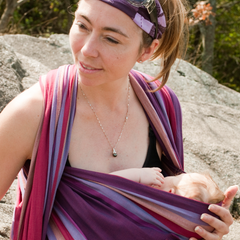 Lastly, babywearing greatly facilitates breastfeeding by keeping your baby against you and your breast. For an optimal position to breastfeed in, a baby wrap or a ring sling will give you the best support and comfort. You can watch our Facebook LIVE event on the topic to learn more.
Lastly, babywearing greatly facilitates breastfeeding by keeping your baby against you and your breast. For an optimal position to breastfeed in, a baby wrap or a ring sling will give you the best support and comfort. You can watch our Facebook LIVE event on the topic to learn more.
Tip 5: Get started!
“Getting started” is sometimes easier said than done, and even more so when talking about a newborn. He’s so tiny it’s easy to fear we might hurt him. Things can get more stressful when it’s our first baby and we lack experience. You really shouldn’t worry: all parents feel the same way at the beginning of their baby’s life.
As mentioned earlier, it’s always a good idea to practice babywearing by yourself without the baby at first. Later on, you shouldn’t hesitate to ask for help, may it be your parents, family members or close friends. They can hold your baby while you’re setting up your wrap or carrier and then help you position the baby correctly. When you’ve done it a few times with assistance, you’ll feel much more comfortable doing it by yourself without stressing out over it.
We recommend that you follow these steps:
- Put on the baby carrier or wrap alone (by doing the desired ties) without your baby.
- Sit down and ask your helper to hand you your baby and to help you put it inside the wrap or carrier.
- Verify your baby’s position so that it is a physiological carry, use the adjustment system so as to have your baby supported but comfortable and make sure that his airways remain unobstructed in any way.
When a baby is born, it’s sometimes more difficult for a dad to develop a strong bond with it since he’s not breastfeeding. Know that babywearing is a wonderful way to make contact with his baby. If you’re interested to know more, Chimpäroo has an article on how to accompany new fathers on their path to parenthood.
You’re now ready! Congratulations, babywearing will become your ally throughout your day! Should you have any questions regarding babywearing, our specialist and founder of Chimparoo, Christine Duhaime, will be happy to answer them. Everything you need to contact her is available here.
*****
We put at the disposition of all parents and soon-to-be parents all kinds of resources to help them become carriers of happiness:
- Our blog handles new topics related to babywearing and parenthood each month.
- Our YouTube videos will help you practice carrying positions to help you throughout the day.
- Our FAQ is able to answer most of our customers’ basic questions.

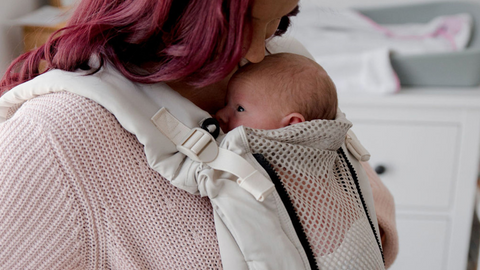
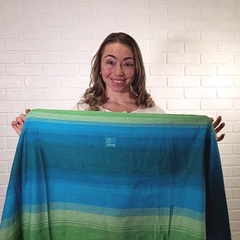
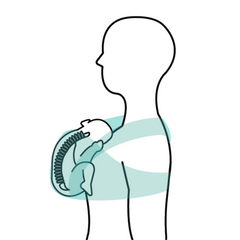
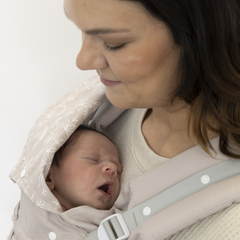

Share:
The Mechanisms of Attachment
5 Tips for Future First-Time Dads